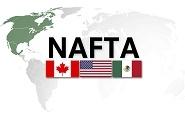Economy

First Round’s Over; What’s Next for NAFTA?
Written by Tim Triplett
August 24, 2017
The first round of talks to upgrade the North American Free Trade Agreement concluded on Sunday, with officials from the U.S., Canada and Mexico pledging to continue negotiations at a rapid pace, possibly concluding by year’s end.
President Trump inserted some added drama into the situation with comments at a campaign-style rally in Arizona on Tuesday, threatening to pull the U.S. from the trade pact. He told the partisan crowd of supporters: “Personally, I don’t think we can make a deal because we have been so badly taken advantage of. They have made such great deals—both the countries, but in particular Mexico—that I don’t think we can make a deal. I think we’ll end up probably terminating NAFTA at some point.” The unscripted comments elicited little reaction from officials in Canada and Mexico, who reportedly view it as a not-unexpected negotiating ploy.
![]() Canada and Mexico have very difficult goals, compared to the U.S. As the talks were about to begin, U.S. Trade Representative Robert Lighthizer asserted: “I want to be clear that [President Trump] is not interested in a mere tweaking of a few provisions and a couple of updated chapters. We feel that NAFTA has fundamentally failed many, many Americans and needs major improvement.” In contrast, Canadian Foreign Affairs Minister Chrystia Freeland and Mexican Secretary of the Economy Ildefonso Guajardo emphasized the need for cooperation in “modernizing” rather than “renegotiating” the 23-year-old trade pact.
Canada and Mexico have very difficult goals, compared to the U.S. As the talks were about to begin, U.S. Trade Representative Robert Lighthizer asserted: “I want to be clear that [President Trump] is not interested in a mere tweaking of a few provisions and a couple of updated chapters. We feel that NAFTA has fundamentally failed many, many Americans and needs major improvement.” In contrast, Canadian Foreign Affairs Minister Chrystia Freeland and Mexican Secretary of the Economy Ildefonso Guajardo emphasized the need for cooperation in “modernizing” rather than “renegotiating” the 23-year-old trade pact.
In a joint statement at the conclusion of round one, the three sides stated: “While a great deal of effort and negotiation will be required in the coming months, Canada, Mexico and the United States are committed to an accelerated and comprehensive negotiation process that will upgrade our agreement and establish 21st century standards to the benefit of our citizens.”
During the five days of meetings, a team of subject matter experts covered more than two dozen different negotiation topics. Negotiators from each country were to continue domestic consultations and work to advance negotiating text through the end of August in preparation for the next session. “The scope and volume of proposals during the first round of the negotiation reflects a commitment from all three countries to an ambitious outcome and reaffirms the importance of updating the rules governing the world’s largest free trade area,” read the joint statement.
With the stage set by the first round of talks, the second round will delve more deeply into the details, and likely unearth some serious points of contention, say observers. One will certainly be the United States’ position on automotive rules of origin. Currently, 62.5 percent of an automobile must be made in North America to qualify for duty-free status within the NAFTA region. Lighthizer has proposed a new mandate that NAFTA vehicles contain “substantial U.S. content,” reducing the content from Europe and Asia. Officials in Canada and Mexico—and leaders in the auto industry itself—fear that such a change would complicate and disrupt a North American automotive supply chain that is working well.
The second round of the NAFTA talks is set for Sept. 1-5 in Mexico City, followed by the third round in late September in Ottawa. Round four will be held in Washington in October. In total, seven rounds are expected through December.

Tim Triplett
Read more from Tim TriplettLatest in Economy

ISM: Manufacturing expansion loses steam after two months of growth
US manufacturing activity slowed in March after two straight months of expansion, according to supply executives contributing to the Institute for Supply Management (ISM)’s latest report.

Chicago Business Barometer rose to 16-month high in March
The Chicago Business Barometer increased for the third-consecutive month in March. Despite this, it still reflects contracting business conditions, as it has since December 2023.

Durable goods orders rise again in February
Transportation equipment led the increase, rising 1.5% to $98.3 billion.

Consumer confidence falls for fourth consecutive month
People remain concerned about inflation, trade policies, and tariffs.

Housing starts ticked up in February
Single-family starts last month hit a rate of 1.10 million, a month-over-month increase of 11.4%, census data shows.
